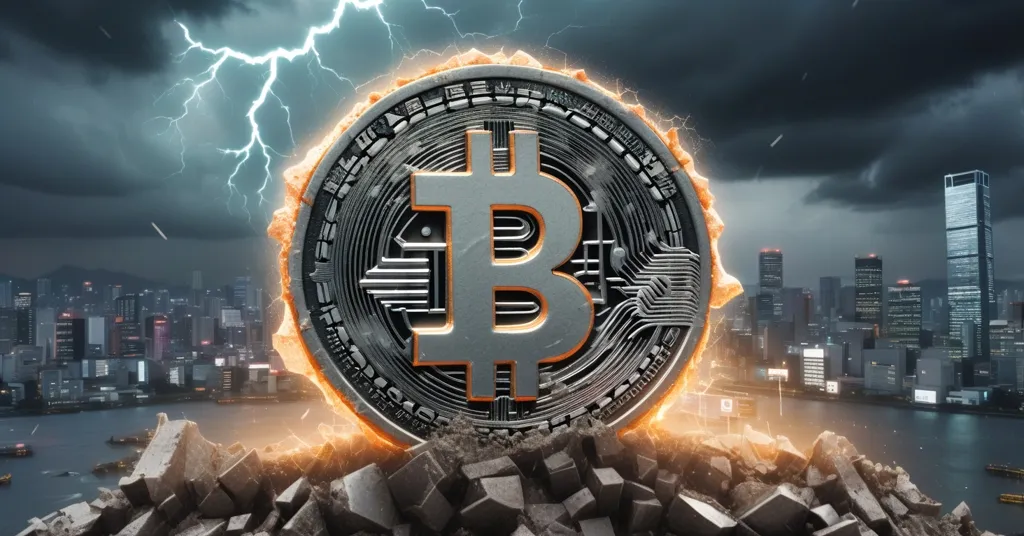Yen Weakens After Ueda’s Osaka Speech: Bitcoin’s Case as a Fiat Hedge Grows

The Yen Weakens After Ueda’s Cautious Osaka Remarks: A Wake-Up Call for Bitcoin and Decentralization
Japan’s monetary policy is making waves again, and the crypto world is taking notice. Bank of Japan (BOJ) Governor Kazuo Ueda’s recent speech in Osaka has rattled currency markets, with the yen dropping 0.35% against the dollar. His cautious tone on interest rate hikes amid global uncertainties has reignited discussions on fiat volatility and the growing appeal of Bitcoin and decentralized finance as alternatives to traditional financial systems.
- Yen Depreciation: Ueda’s remarks led to a 0.35% drop, with the yen trading at around 147.67 per dollar.
- BOJ Hesitancy: No clear signal on rate hikes, despite inflation above the 2% target for over three years.
- Crypto Relevance: Fiat struggles could drive interest in Bitcoin as a hedge against currency devaluation.
Ueda’s Cautious Outlook: Yen Takes a Hit
Addressing business leaders in Osaka, BOJ Governor Kazuo Ueda painted a mixed picture of Japan’s economy, as detailed in reports about Ueda’s remarks in Osaka causing yen weakening. He acknowledged that inflation is trending toward the central bank’s long-standing 2% target—a milestone Japan has struggled to reach after decades of deflationary pressure. Yet, he quickly threw cold water on any hopes for bold action, citing global economic headwinds like weaknesses in the U.S. labor market and the potential for new U.S. tariffs under shifting trade policies. These factors, he warned, could discourage Japanese firms from raising wages—a key ingredient for sustainable, demand-driven inflation that the BOJ desperately needs to see.
For those new to central banking lingo, a “dovish stance” means a preference for keeping monetary policy loose, with low interest rates to stimulate growth, as opposed to a “hawkish” approach that favors tightening through rate hikes to curb inflation. Ueda’s dovish tone—lacking any firm commitment to raising rates—sent a clear message to markets: don’t expect aggressive moves anytime soon. The result was immediate. The yen weakened by 0.35%, settling at approximately 147.67 against the U.S. dollar. As Akira Moroga, Chief Market Strategist at Aozora Bank, pointed out, this sell-off was a direct reaction to Ueda’s hesitancy. Markets hate uncertainty, and Japan’s currency paid the price.
“If the baseline scenario for economic activity and prices outlined so far is realized, the bank, in accordance with improvement in economic activity and prices, will continue to raise the policy interest rate.” – Kazuo Ueda, BOJ Governor
This statement from Ueda offers a conditional nod to future rate hikes, but it’s far from a guarantee. It’s more like a polite “we’ll see” at a dinner invite—hardly the conviction traders were hoping for. The BOJ’s history doesn’t inspire much confidence either. After a decade of aggressive stimulus with near-zero or negative interest rates, they finally ended their massive easing program last year and nudged rates to 0.5% in January, marking the first hike in years. But with inflation stubbornly above 2% for over three years, the central bank still tiptoes around decisive action, haunted by the specter of past deflationary spirals.
BOJ Policy Dilemma: Rate Hike or Endless Waiting?
The market is buzzing with speculation about the BOJ’s next move. Traders in the overnight swaps market—a financial arena where bets are placed on central bank actions—now estimate a 60% chance of a rate hike at the upcoming October 29–30 meeting, a significant jump from just 22% in early September. But not everyone is sold on this timeline. Economists like Shotaro Mori of SBI Shinsei Bank suggest a delay to December might be more realistic, especially if fresh economic data or global disruptions like U.S. tariffs throw a curveball. Tightening policy is like turning off a faucet to slow the flow of money—do it too soon, and you risk choking growth; wait too long, and inflation could spiral.
Inside the BOJ, consensus is cracking. At the September meeting, two board members, Naoki Tamura and Hajime Takata, voted for an immediate rate hike—a rare dissent under Ueda’s watch. Even a traditionally dovish policymaker has shifted tone, hinting at openness to tightening if conditions align. This internal push-and-pull reflects the broader uncertainty gripping Japan’s monetary strategy. Add to that the BOJ’s latest Tankan survey—a quarterly report measuring business confidence among Japanese companies—which showed favorable sentiment aligning with the bank’s growth projections. Deputy Governor Shinichi Uchida echoed this optimism, but Ueda himself flagged a major hurdle: persistent food price hikes are squeezing household budgets, curbing consumption, and stalling the kind of inflation momentum the BOJ craves.
On a brighter note, Ueda hinted that underlying inflation—excluding volatile factors like food and energy—might start climbing, a shift from the BOJ’s more sluggish September forecast of gradual growth. Still, global risks loom large. Potential U.S. tariffs could hammer Japanese exporters, while a softening U.S. labor market might dampen demand for Japan’s goods. These aren’t just abstract concerns; they directly impact corporate profits and the willingness of firms to hike wages, which in turn affects the BOJ’s policy calculus. It’s a messy web, and Ueda’s reluctance to act decisively underscores just how fragile fiat systems can be when the world gets choppy.
Bitcoin as a Safe Haven Amid Fiat Woes
So, why should crypto fans care about a central bank speech in Osaka? Simple: fiat volatility is Bitcoin’s best marketing campaign. A weakening yen often drives investors to seek assets untethered to central bank whims, and Bitcoin, with its fixed supply of 21 million coins and decentralized network, fits the bill as a potential store of value. Historically, Japan has been a key player in the crypto space—think back to the infamous Mt. Gox exchange, once handling over 70% of global Bitcoin trades before its 2014 collapse. While that’s a cautionary tale, it highlights Japan’s early embrace of digital currencies. Today, with the yen sliding, local investors might again turn to BTC as a hedge against currency devaluation.
Look at past trends for context. During yen depreciation episodes in 2022, when the currency hit multi-decade lows, Bitcoin trading volume on Japanese exchanges like bitFlyer spiked noticeably. While exact figures vary, data from platforms like CoinGecko often show upticks in BTC/JPY pairs during such periods. Japan also ranks among the top nations for crypto adoption, partly due to its tech-savvy population and government recognition of Bitcoin as legal tender since 2017. A weaker yen could amplify this trend, pushing more retail and institutional players toward digital assets as a shield against fiat erosion.
But there’s a flip side, and it’s not all sunshine and HODL memes. Japan’s crypto regulations, while progressive in some ways, are strict on anti-money laundering (AML) and know-your-customer (KYC) requirements. Plus, hefty taxes on crypto gains—sometimes as high as 55% for high earners—can deter casual investors. So, while yen weakness might spark interest in Bitcoin, bureaucratic hurdles could slow the stampede. Still, every fiat misstep is a reminder of why Bitcoin exists: to offer an escape from centralized control and currency debasement. Moments like these are why we champion decentralization, even if the road to mass adoption is paved with potholes.
Beyond Bitcoin: Altcoins and DeFi in the Mix
Bitcoin maximalists—and I lean that way myself—will argue that BTC is the ultimate answer to fiat’s flaws, a pure, unadulterated store of value that doesn’t mess around with bells and whistles. They’ve got a damn good point. But let’s not sleep on the innovation happening elsewhere in the crypto space. Ethereum and its decentralized finance (DeFi) ecosystem offer tools that Bitcoin doesn’t prioritize, and they could appeal to Japanese investors seeking more than just a digital gold equivalent. Platforms like Aave and Uniswap allow users to lend, borrow, or swap assets without middlemen, creating a parallel financial system that sidesteps traditional banks entirely.
For the uninitiated, DeFi is a broad term for blockchain-based applications that replicate or reinvent financial services—think loans, insurance, or savings accounts—without centralized institutions. Ethereum’s smart contracts, self-executing code on its blockchain, power these apps, enabling trustless transactions. In a country like Japan, where trust in tech is high but fiat is wobbling, DeFi could provide alternatives for those wary of both yen volatility and rigid banking systems. Imagine a small business owner using Aave to secure a loan in stablecoins pegged to the dollar, bypassing local interest rates dictated by the BOJ. It’s not a pipe dream; it’s happening now, albeit on a smaller scale.
That said, altcoins and DeFi come with their own baggage. Ethereum’s network fees can be brutal during peak usage, and the complexity of these platforms often scares off newcomers. Plus, the regulatory scrutiny on DeFi globally—Japan included—means users aren’t exactly operating in a Wild West anymore. Bitcoin’s simplicity and first-mover advantage still make it the king of crypto hedges, but the diversity of solutions in this space is what fuels the broader financial revolution. Different tools for different needs, and that’s a strength, not a weakness.
Risks and Reality Check: Crypto Isn’t Bulletproof
Before we get carried away with visions of Bitcoin saving the day, let’s pump the brakes. Crypto isn’t immune to the same global storms that rattle fiat markets. If U.S. tariffs or labor market woes spiral into a broader economic slowdown, risk assets—including Bitcoin and altcoins—could take a serious beating. Look at 2022: when central banks worldwide hiked rates to combat inflation, BTC’s price cratered from nearly $69,000 to under $17,000 in months, moving in lockstep with plunging stock indices. Correlation with traditional markets is real, especially during panic sell-offs.
Even in Japan, where Bitcoin might see a bump from yen weakness, local adoption isn’t guaranteed to translate into price pumps. Speculative bubbles in crypto are notorious—remember the 2017 ICO craze or the 2021 meme coin mania? A rush into BTC could just as easily be a fleeting FOMO spike followed by a brutal dump. And let’s not forget hacks, scams, and exchange failures that still plague the space. Decentralization is the goal, but the ecosystem isn’t fully there yet. We’re building the plane while flying it, and turbulence is part of the deal.
Why Decentralization Matters Now More Than Ever
Ueda’s remarks and the BOJ’s indecision are a stark reminder of fiat’s fragility. Central banks are like lumbering dinosaurs, stumbling through geopolitical minefields with policies that lag behind reality. Japan’s balancing act—juggling inflation, wage stagnation, and global risks—mirrors the cracks in traditional finance worldwide. This is precisely why Bitcoin’s trustless, borderless nature is a game-changer. It doesn’t need a boardroom vote or a governor’s speech to function. It just works, 24/7, no permission required.
Yet, the path to a decentralized future isn’t a straight line. Regulatory pushback, scalability issues, and public skepticism are real barriers. Japan’s own strict crypto laws, while offering some legitimacy, also stifle the freedom blockchain promises. Still, every fiat failure chips away at the old system’s credibility. Privacy, autonomy, and disruption of the status quo—these aren’t just buzzwords; they’re the stakes. We’re not peddling hopium here. The fight for decentralization is messy, but it’s worth it. Fiat’s creaking under its own weight, and crypto’s moment to shine is closer than ever—if we can navigate the chaos.
Key Takeaways and Questions for Crypto Enthusiasts
- What’s the link between yen weakness and Bitcoin’s appeal?
A depreciating yen can push investors toward Bitcoin as a store of value, offering a hedge against fiat devaluation, though broader market risks remain. - How might BOJ rate hikes affect crypto markets?
A rate hike could strengthen the yen, potentially reducing Bitcoin’s allure as a hedge, while also impacting global risk sentiment that often drags crypto prices. - Are global uncertainties a bigger threat to crypto than local policy?
Yes, issues like U.S. tariffs or economic slowdowns could trigger market-wide downturns, hitting Bitcoin and altcoins harder than BOJ decisions alone. - Do Japan’s crypto regulations impact adoption during yen struggles?
Absolutely, strict AML/KYC rules and high taxes on gains can deter investors, even as fiat volatility drives interest in digital assets. - Does this strengthen the case for decentralization?
Hell yes—central bank hesitancy and fiat instability underscore why Bitcoin and blockchain’s promise of freedom and privacy are more critical than ever.



